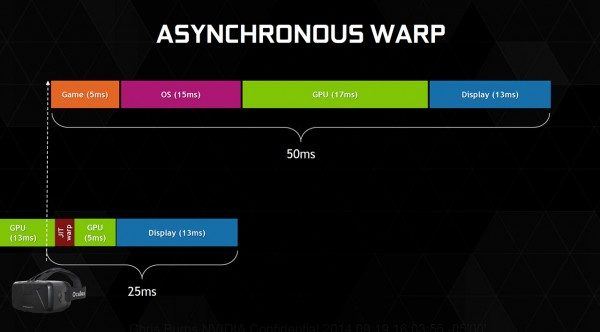The Convrge team pulled somewhat of a coup last week when Nathan Reed from nVidia, gave his presentation “VR Direct: How NVIDIA Technology Is Improving the VR Experience” to an assembled audience inside Convrge’s charmingly polygonal VR social space.
Convrge seems to be blossoming recently as its founders, Shawn Whiting and Hayden Lee work overtime to bring users compelling reasons to log on. The immersive social application can offer shared movie watching and slideshow presentations, which makes it perfect for virtual reality talks and lectures.
Last week, Nathan Reed, Graphics Programmer at nVidia, lectured the audience on what virtual reality enthusiasts can expect from the GPU giant’s forthcoming ‘VR Direct’ enabled video drivers. These virtual reality specific enhancements aim to reduce latency whilst increasing performance, and represent nVidia’s play to stay ahead of the competition when consumer VR lands in the coming months.
Of particular interest are features to cut perceived latency, such as asynchronous timewarp (transforming the rendered view based on the latest input data) and VR SLI (utilising dual GPUs, each rendering for one eye). The latter Reed touched on briefly, and it seems was perhaps misinterpreted; in the Oculus section of Reddit, a discussion sprang up speculating on VR Direct’s usage at GDC and in particular whether VR SLI had been used to present Oculus’ hugely impressive Thief in the Shadows demo on the Crescent Bay feature prototype.
We asked for clarification on this point and Reed responded:
To clarify, high-priority contexts and VR SLI should be coming to public drivers with the next few months, though I’m not sure if it will be in the very next driver version or a later one. However, we actually weren’t using either of those features for the Smaug demo, or any of the demos we showed at GDC. We’ve shared a prerelease driver enabling these features with Oculus and a few key game developers, and would be happy to share it with others (under NDA) as well. However we haven’t actually shown a full-fledged demo of high-priority contexts or VR SLI in public yet.
So it seems VR Direct is progressing well, but we’ll have to wait a little longer to see a mature driver in the wild.
Check out Convrge at their web page here. And for a more in-depth summary of the subject matter in Nathan’s talk, you can read our live blog direct from GDC 2015 here which includes some slides.







